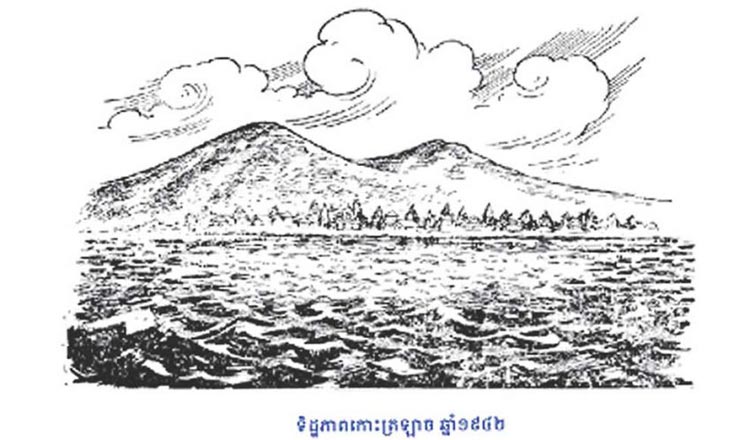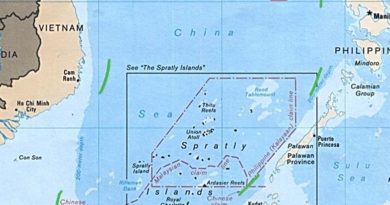PHNOM PENH: The Forgotten Jailbird Champion
A sketch of Con Son island (known as Koh Tralach in Khmer) in 1942. Supplied
.
At the peak of the World War II, the anti-French nationalist movement, led by Buddhist monks and a handful of pro-democracy, French-educated Cambodian elites, emerged in Cambodia. In the meantime, the French administration countered by arresting many of the nationalist activists and exiled them to their notorious Con Dao prison on Con Son Island, off the coast of southern Vietnam. One of the political prisoners was Bun Chanmol, who wrote a best-selling autobiography in 1971. Most of the book is about the three years that Chanmol spent on Con Son Island, and one of the most remarkable occurrences mentioned in it is the writer’s rise to become the prisoners’ “kickboxing champion”. Taing Rinith documents the story of jailbird title-holder.
ADS by Cloud 9:
.
– SPACE RESERVE FOR YOUR ADVERTISEMENT –


.
ADS by Cloud 9:
.
– SPACE RESERVE FOR YOUR ADVERTISEMENT –

It was a New Year’s Day evening in 1943 in Con Son Prison, which housed thousands of convicts from Cambodia, Laos and Vietnam. On such an important holiday, the “French warden”, despite his well-known cruelty and strictness, organised a kickboxing event to be watched by both prisoners and civilians. It featured six “international” fights between Vietnamese and Cambodian prisoners.
The main fight was for the championship title of the prison. The defending champion was a Vietnamese prisoner known by the name Ah Be, who was reportedly undefeated for the past seven years. The challenger was Bun Chanmol, a 22-year-old political prisoner who had been sentenced to five years in Con Dao prison and 15 years in exile.
ADS by Cloud 9:
.
– SPACE RESERVE FOR YOUR ADVERTISEMENT –

Chanmol was arrested about one year ago after he joined a large demonstration, which was held to call for the release of Hiem Chiev, a highly respected Buddhist monk and an activist in the Nationalist Movement. The protest, which would be broken by the French, was led by Son Ngo Thanh, the leader of the nationalist movement, and Pach Chhoeun, the publisher of a pro-independence Khmer-language newspaper, Nagaravatta.
As Chanmol was walking to the ring, surrounded by a large audience of French, Vietnamese and Cambodian attendees, he was praying to Buddha and his ancestors’ spirits to assist him in his match. There was a rumour circulating the island that Ah Be had killed most of his foes in the ring. In fact, on Con Son Island, where medical supplies were scarce and the physicians careless, even a small wound could be fatal. Chanmol was jittery, but he longed to fight for the honour of his motherland.
“I had hesitated but eventually agreed to fight,” Chanmol wrote later about this experience in Kok Niyobay (Political Prison), his autobiography published in 1971. “Ah Be had caused fear to everyone on the island, and no one was courageous enough to face him, except I.”
The bout started almost immediately after both fighters entered the ring. With their fists wrapped with crude fabric instead of wearing gloves, Ah Be and Chanmol tried to knock down one another with their punches, knees and kicks. When the first round was about to end, an uppercut followed by a knee strike from Chanmol felled Ah Be before he gave up at the count of seven. Chanmol was declared the new champion of Con Son Island.
ADS by Cloud 9:
.
– SPACE RESERVE FOR YOUR ADVERTISEMENT –

“A loud cheer exploded from the audience, raising my heckles,” Chanmol wrote.
According to Chanmol’s book, the victory helped raised his status on the prison island “that killed people itself”. Praising his fighting skill, the warden promoted him to a member of the Secret Group, who was responsible for capturing escaping prisoners, and later a caporal (foreman) over the ferocious prisoners in an area known as Guérêt on Con Son Island. Eight months later, Chanmol had to defend his title against and defeated the newly arrived Ya Ba Tong, who had been recognised at “the Indochina Champion” from Vietnam.
“When I knocked out Ya Ba Tong, I know it was the biggest victory in my life,” Chanmol penned down about his victory.
Obviously, the narration about prison’s boxing championship may sound like a plot from one of Jean-Claude Van Damme’s martial arts action films rather than a true story. Yet, there are some evidence to support it.
ADS by Cloud 9:
.
– SPACE RESERVE FOR YOUR ADVERTISEMENT –


.
ADS by Cloud 9:
.
– SPACE RESERVE FOR YOUR ADVERTISEMENT –

In his 1995 book Pravat Nak Tasou Khmer (The History of Khmer Heroes), Bun Than, a jewellery tycoon and an old friend of Chanmol who was also involved in the Nationalist Movement, recognised Chanmol’s kickboxing talents.
“He (Chanmol) was a brave man and an outstanding sportsman and boxer,” Than wrote. “He was always competing at all tournament …held during Khmer New Year.”
In a review of the book in 1972, David Chandler, an American scholar and Cambodia expert, praised Chanmol’s autobiography.
“As a description of conditions there, his book is well worth reading, for he has a good memory and a vigorous style,” Chandler wrote in Journal of the Siam Society.
ADS by Cloud 9:
.
– SPACE RESERVE FOR YOUR ADVERTISEMENT –

“In its own right, the book is a valuable addition to the historical record.”
When contacted 45 years later, Chandler says his opinion remains the same.
“The rest of the book is also accurate but has a narrower, more personal focus,” Chandler says.
Not everyone agrees of course. Sambo Manara, a well-known Cambodian historian, shows some doubt about the reliability of Chanmol’s memoir.
“The stories in the book are vulnerable to bias,” he said. “They could have been made around an individual’s opinion and personal experience which could be affected by his personal values and tendencies or coincidental to a particular time.”
ADS by Cloud 9:
.
– SPACE RESERVE FOR YOUR ADVERTISEMENT –

Chanmol would end up spending just three years on Con Son as he was released by the Japanese, who had seized the French colonies. His times in Con Dao prison did little to temper his anti-colonial attitudes. In 1945, he co-founded the Khmer Issarak, an anti-French movement, but later defected because he was critical of their violence.
In 1951, he became a member of former Prime Minister Ieu Koeus’s Democratic Party, until King Norodom Sihanouk dissolved the parliament in 1953, and eventually worked under Lon Nol as an undersecretary of propaganda and religion.
According to Chhang Song, the former minister of information under Lon Nol and another friend of Chanmol, Kok Niyobay was a bestseller in Phnom Penh and prompted a second edition just three months after its first publication.
Nothing is known about Chanmol, the “undefeated Con Dao Kickboxing champion”, when the Khmer Republic government collapsed in 1975. Yet, according to his friend Chhang Song, Chanmol was executed by the Khmer Rouge force, who entered Phnom Penh on April 17, 1975.
“He did not leave Phnom Penh when the city was taken over by Khmer Rouge,” Song says. “He was not only a talented boxer but also a real patriot.”
ADS by Cloud 9:
.
– SPACE RESERVE FOR YOUR ADVERTISEMENT –


.
Taing Rinith / Khmer Times Share:
ADS by Cloud 9:
.
– SPACE RESERVE FOR YOUR ADVERTISEMENT –

NOTE : All photographs, news, editorials, opinions, information, data, others have been taken from the Internet ..aseanews.net | [email protected] |
.
For comments, Email to :
Goldenhands Arts Club | [email protected]| Contributor









